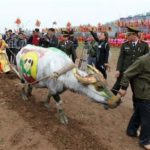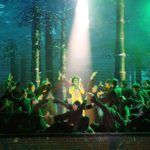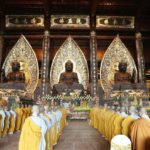Traditional water puppetry, once hugely popular, is struggling to capture the interest of younger generations, requiring the efforts of both artists and regulators to preserve this ancient art form.
The younger generation’s disinterest
| A water puppet performance at the Thang Long Water Puppet Theater. Photo: Hanh Pham |
Once a spiritual practice for the people of the Red River Delta and Vietnam, traditional water puppetry now faces the sad reality of generating little attention, especially among the younger population.
“I think there are now so many entertainment options and alternatives for young people to choose from instead of traditional arts like water puppetry, especially when the plays of this art form have remained unchanged for hundreds of years, which decreases people’s interest,” said Quynh Chi, a student at Vietnam National University in Hanoi.
According to Minh Ha, an employee of the Thang Long Water Puppet Theater, the majority of customers who buy tickets for water puppet shows are foreign tourists, with only a few curious domestic travelers attending on special holidays such as Vietnam’s National Day on September 2 or the Mid-Autumn Festival.
In today’s globalized world, exotic cultures have made their way to Vietnam, resulting in a change in local preferences for performing arts. Young people now have more diverse options to enjoy the arts, which has distanced them from traditional forms like water puppetry.
Revitalizing the art form
| A scene from a water puppet show. Photo: Hanh Pham |
Some argue that the first step in attracting young audiences to traditional performing arts, including water puppetry, should be increased promotion. Effective communication plays a crucial role in helping the younger generation understand and appreciate this art form. By doing so, both young people and adults are more likely to attend traditional art theaters.
Water puppeteer Phan Thanh Liem believes that integrating traditional arts into schools is essential to familiarize children with them. By exposing and inspiring children to traditional arts, including water puppetry, from a young age, they are more likely to develop an appreciation for them.
In the past, some water puppet troupes attempted to promote water puppetry in schools, but their efforts were largely unsuccessful, as they primarily targeted high school students. The earlier children are introduced to traditional arts, the more connected they feel to them. Unfortunately, even in rural areas, where many ancient performing arts originated, young people show little interest in traditional forms.
| Young spectators enjoy a water puppet show at Dao Thuc Village, Dao Thuc Village, Dong Anh District, Hanoi. Photo: Roi nuoc Dao Thuc |
In addition to incorporating contemporary elements into traditional plays, experts suggest that water puppetry needs to explore fresh and exciting themes that are relevant to today’s audience. The storyline is a vital component of water puppetry, as it should not only be entertaining but also convey meaningful messages that resonate with the audience for a long time.
Liem emphasizes that artists’ dedication and passion for their work are crucial in keeping young audiences engaged with traditional art forms. Alongside better promotion, innovation and creativity are also essential.
Meritorious artist Nguyen The Long, deputy director of the Vietnam National Puppetry Theater, highlights the potential of technology in puppetry, such as the use of sound and lighting equipment.
| Water puppet characters. Photo: Roi nuoc Dao Thuc |
“Traditionally, LED lighting has never been used in puppet shows. However, we are now utilizing it to enhance the visual aspects of performances and convey messages more effectively. While there are various ways to innovate, it is crucial that the essence of our nation and the spirit of water puppetry remain intact,” said Long.
Preserving and sharing the quintessence and values of Vietnam’s traditional culture and art with a wider audience, especially young people, is a challenge that requires the collaboration of artists, cultural management agencies, and those who cherish the country’s cultural heritage.
According to craftsman Phan Thanh Liem, to preserve traditional values, it is essential to distinguish between what can be innovated and what should remain unaltered while maintaining the core principles. If every artist takes too many liberties, the original values will fade away within a few years, and future generations will not understand what traditional art truly represents.
“Traditional art and creativity go hand in hand, but creativity should always be within reasonable boundaries.”
| Artisans from Dao Thuc Village are preparing for a water puppet show. Photo: Roi nuoc Dao Thuc |
|
Water puppetry is a traditional art form dating back to the 11th century Ly Dynasty. Villagers in the Red River Delta and other rice-growing regions of northern Vietnam used to stage water puppet shows to celebrate the end of the rice harvest, religious festivals, and important occasions. |
Tam Chuc Pagoda – Ancient beauty amidst majestic scenery
Covering 5,100 ha, Tam Chuc complex is a perfect combination of ancient beauty and the mighty of the immense mountain.













